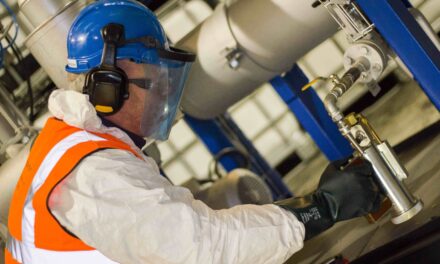 When designing equipment to be used in hazardous area applications, there are a variety of issues that have to be addressed in terms of specifications and user requirements. Bulgin’s design engineer Dave Ferry explains
When designing equipment to be used in hazardous area applications, there are a variety of issues that have to be addressed in terms of specifications and user requirements. Bulgin’s design engineer Dave Ferry explains
It is sometimes easy to forget that hazardous areas are all around us. Even the humble light switch can pose a threat to personnel and plant safety. In a domestic setting, the light can often emit a harmless but visible spark as the switch is turned on or off.
However, put this switch in an environment where flammable or explosive dusts and gases are present, and this spark is now a serious health and safety concern. Hazardous area equipment is required in a number of public spaces ranging from airports, waste disposal, petrochemical and energy industries to the manufacturers and suppliers of machines, equipment and systems where explosive atmospheres may exist.
All components used in hazardous areas must comply with stringent criteria set out by the ATEX Directive for equipment deployed in the EU – cutting corners is not an option when it comes to safety. The directive assures design engineers that the component parts they choose perform to the highest standard in extreme temperatures, harsh environments and in flammable or explosive atmospheres.
Put to the test
To meet the standards outlined in the ATEX Directive, a product must pass an arduous testing process. The parameters of acceptable performance are not on a simple pass or fail basis – the product must maintain integrity and the highest standards of performance in extreme temperatures with a wide comfort margin before an ATEX approval certificate is issued.
Cold impact testing can be challenging, particularly with plastics, as products must perform well below their certified temperature levels when unmated to achieve certification for Zone 2 and Zone 22. It can be difficult for a design engineer to find a material which is affordable, durable, flexible and compatible with in-house moulding machines and tooling.
This can often be the biggest headache in the design process. Many plastics perform well at high temperatures but become very brittle in sub-zero temperatures, and cold impact testing is often far more demanding than testing at high temperatures. Newer materials on the market, including tough high grades of polyester, are particularly useful for hazardous area equipment and do not crack or splinter at lower temperatures.
Environmental sealing can further enhance the performance of a connector. For example, sealing to IP68 ensures protection against even the most arduous dust and water borne environments under a wide temperature range. Sealing caps maintain sealing integrity when connectors are not mated. However, like the main body of a connector, the caps must also meet the standards outlined in ATEX testing. Sealing caps, which are often shaped like a cup, tend to perform well in testing until they reach temperatures of -25°C. Polycarbonate is often chosen for sealing caps as it performs well in more extreme cold temperature ranges.
 The end user
The end user
Design engineers should also consider the end user when designing hazardous area equipment. An easy to access interface is essential and simple adjustments can have significant impact on ease of use. Consider a worker who must wear heavy protective clothing to complete maintenance works in a harsh environment. A ribbed casing on the connector will make the part far easier to grip in a gloved hand and will make the component or connector easily operable for the user.
This also extends to the life of associated cabling and other attachments as abuse is reduced. Small changes such as these really make the difference to the end user and thinking further down the supply chain, will help the design engineer to judge the merits of a particular component part over the alternative options.
While performance is the primary deciding factor when choosing component parts, a design engineer will also be driven by cost considerations. The unit price of connectors varies greatly depending on where the product is being deployed because this affects the materials that are chosen. For this reason, costs for a mating pair of connectors can differ considerably between Zone 2 plastic connectors and Zone 1 metal connectors.
Exploring the possibilities
To meet this need, Bulgin launched its EXPlora range of ATEX Zone 2 and Zone 22 connectors with the objective of meeting the characteristics determined by the harsh environments the product will be deployed in. The connectors are offered in 2-, 3-, 4-, 5-, 7- and 10-pole variants and in four body styles including cable, in-line cable, panel and flange fixing. Each contact insert is available with either pin or socket contacts to allow pairing, and either can be used with any of the body styles to give the maximum choice of combinations.
To date, the EXPlora range has featured in a variety of applications from the manufacturers of ancillary electrical equipment such as cameras, motors, pumps, lighting equipment, process and control gear to more simple use in factories and plant where hazardous or explosive atmospheres can be caused by flammable gases, mists, vapours or by combustible dusts. These include mills and grain stores, paint and ink manufacturers, timber mills and processors, cement works, shipyards and sewage treatment.
While the ATEX directive leaves little room for variances in performance, customisation is still possible. Bulgin can offer a custom designed solution for products in the EXPlora range to meet ATEX standards, ensuring customers can adapt a component to suit their requirements without sacrificing safety and performance.






